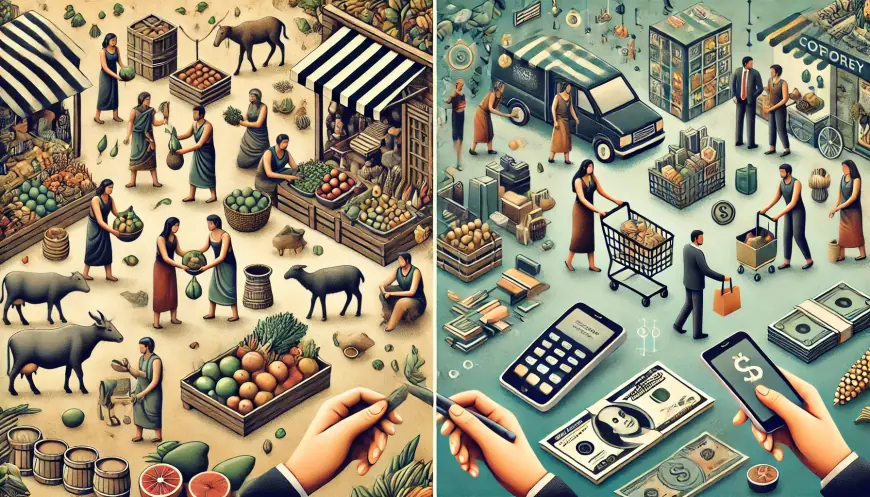Barter vs. Currency: Key Differences and Examples
This blog delves into the key differences between barter trade and currency trade, highlights their advantages and disadvantages, and explores real-world examples to understand their practical implications.

Trade is an essential aspect of human civilization, facilitating the exchange of goods and services to meet the diverse needs of individuals and societies. Over time, the methods of trade have evolved, transitioning from barter trade to currency trade. While both systems aim to fulfill the same fundamental purpose—exchange—they differ significantly in their mechanisms, challenges, and impacts on economies.
This blog delves into the key differences between barter trade and currency trade, highlights their advantages and disadvantages, and explores real-world examples to understand their practical implications.
Understanding Barter Trade
Barter trade is the direct exchange of goods and services without using a medium of exchange such as money. In a barter economy, individuals trade items or services of equivalent perceived value. For example, a farmer might exchange a sack of rice for a carpenter's help in building a barn.
Key Features of Barter Trade:
-
Direct Exchange: Barter requires the mutual agreement of value between two parties.
-
Double Coincidence of Wants: Both parties must want what the other offers at the same time.
-
No Standard Unit of Value: The value of goods and services is subjective and negotiated case by case.
-
Localized Transactions: Barter systems often occur within small communities or close-knit networks.
Advantages of Barter Trade:
-
Simplicity: It requires no complex systems or institutions.
-
No Need for Money: Barter is viable in situations where currency is unavailable or unstable.
-
Mutual Benefit: Each party gets what they need without monetary transactions.
Disadvantages of Barter Trade:
-
Double Coincidence of Wants: It can be challenging to find someone who has what you want and wants what you have.
-
Lack of Standardization: Determining equivalent value can be subjective and inconsistent.
-
Difficulty in Storing Wealth: Goods can perish, deteriorate, or lose value over time.
Understanding Currency Trade
Currency trade involves the use of money—a universally accepted medium of exchange—to facilitate transactions. In a money economy, individuals trade goods and services in exchange for currency, which can later be used to purchase other items.
Key Features of Currency Trade:
-
Use of Money: Currency acts as a medium of exchange, store of value, and unit of account.
-
Standardization: Money provides a consistent measure of value.
-
Broader Reach: Currency trade is not confined to local transactions and supports global trade.
-
Deferred Payments: Currency allows for credit and future payments.
Advantages of Currency Trade:
-
Efficiency: Eliminates the need for a double coincidence of wants.
-
Standard Unit of Value: Simplifies pricing and comparisons.
-
Global Trade: Enables international commerce and economic expansion.
-
Wealth Storage: Money can be stored and invested, retaining its value over time.
Disadvantages of Currency Trade:
-
Inflation and Devaluation: Currency can lose value due to economic factors.
-
Dependence on Institutions: Currency systems rely on central banks, governments, and financial institutions.
-
Inequality: Access to money may create disparities in wealth and opportunities.
Key Differences Between Barter Trade and Currency Trade
|
Aspect |
Barter Trade |
Currency Trade |
|
Medium of Exchange |
Direct exchange of goods/services |
Money as a medium of exchange |
|
Valuation |
Subjective and negotiated |
Standardized through currency |
|
Double Coincidence |
Required |
Not required |
|
Scalability |
Limited to small communities |
Enables global trade |
|
Efficiency |
Time-consuming |
Quick and streamlined |
|
Wealth Storage |
Difficult |
Easy and reliable |
Real-World Examples of Barter and Currency Trade
Barter Trade in Action
-
Historical Example:
In ancient Mesopotamia, people bartered goods such as grain, livestock, and tools. The barter economy thrived before the introduction of money, with exchanges often facilitated within local markets. -
Modern-Day Barter:
Even today, barter trade exists in various forms. For example, during economic crises, when currency loses its value, people resort to bartering essential goods. Additionally, barter networks and online platforms like Bartercard facilitate modern barter exchanges.
Currency Trade in Action
-
Ancient Currency:
The first coins were minted around 600 BCE in the ancient kingdom of Lydia (modern-day Turkey). Coins and later paper money revolutionized trade by providing a standardized medium of exchange. -
Global Currency Trade:
Today, currency trade dominates the global economy. The foreign exchange market (Forex) is a prime example, where currencies are traded daily, amounting to trillions of dollars in transactions. The use of digital currencies like Bitcoin has further expanded the scope of currency-based trade.
Impact on Economies
Barter Economy:
Barter trade works effectively in small, self-sufficient communities or during times of financial instability. However, it struggles to scale up or sustain large, complex economies. The inefficiencies of barter are a significant reason for the evolution of money economies.
Money Economy:
Currency trade has enabled the growth of global economies, industrialization, and technological advancement. It fosters specialization, investment, and economic development. However, challenges such as inflation, inequality, and economic crises highlight the system's vulnerabilities.
Conclusion
While both barter trade and currency trade aim to facilitate the exchange of goods and services, they represent two fundamentally different approaches to trade. Barter trade, with its simplicity and reliance on direct exchanges, is ideal for localized, small-scale transactions. On the other hand, currency trade, with its efficiency and scalability, forms the backbone of modern global economies.
Understanding the difference between barter trade and currency trade helps us appreciate the evolution of commerce and its impact on societal growth. As economies continue to evolve, hybrid models, including digital currencies and barter networks, may emerge to address the shortcomings of both systems.
Whether it’s the barter economy or the money economy, the underlying goal remains the same: to enable trade, foster cooperation, and drive progress.
This blog captures the essence of barter and currency trade, providing a comprehensive view of their differences and implications for economic systems.
What's Your Reaction?
 Like
0
Like
0
 Dislike
0
Dislike
0
 Love
0
Love
0
 Funny
0
Funny
0
 Angry
0
Angry
0
 Sad
0
Sad
0
 Wow
0
Wow
0

















































